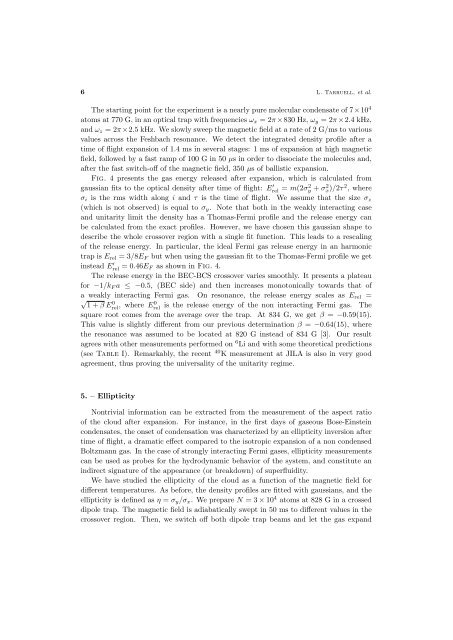Martin Teichmann Atomes de lithium-6 ultra froids dans la ... - TEL
Martin Teichmann Atomes de lithium-6 ultra froids dans la ... - TEL
Martin Teichmann Atomes de lithium-6 ultra froids dans la ... - TEL
You also want an ePaper? Increase the reach of your titles
YUMPU automatically turns print PDFs into web optimized ePapers that Google loves.
6 L. Tarruell, et al.<br />
The starting point for the experiment is a nearly pure molecu<strong>la</strong>r con<strong>de</strong>nsate of 7×10 4<br />
atoms at 770 G, in an optical trap with frequencies ωx = 2π ×830 Hz, ωy = 2π ×2.4 kHz,<br />
and ωz = 2π×2.5 kHz. We slowly sweep the magnetic field at a rate of 2 G/ms to various<br />
values across the Feshbach resonance. We <strong>de</strong>tect the integrated <strong>de</strong>nsity profile after a<br />
time of flight expansion of 1.4 ms in several stages: 1 ms of expansion at high magnetic<br />
field, followed by a fast ramp of 100 G in 50 µs in or<strong>de</strong>r to dissociate the molecules and,<br />
after the fast switch-off of the magnetic field, 350 µs of ballistic expansion.<br />
Fig. 4 presents the gas energy released after expansion, which is calcu<strong>la</strong>ted from<br />
gaussian fits to the optical <strong>de</strong>nsity after time of flight: E ′ rel = m(2σ2 y + σ 2 x)/2τ 2 , where<br />
σi is the rms width along i and τ is the time of flight. We assume that the size σz<br />
(which is not observed) is equal to σy. Note that both in the weakly interacting case<br />
and unitarity limit the <strong>de</strong>nsity has a Thomas-Fermi profile and the release energy can<br />
be calcu<strong>la</strong>ted from the exact profiles. However, we have chosen this gaussian shape to<br />
<strong>de</strong>scribe the whole crossover region with a single fit function. This leads to a rescaling<br />
of the release energy. In particu<strong>la</strong>r, the i<strong>de</strong>al Fermi gas release energy in an harmonic<br />
trap is Erel = 3/8EF but when using the gaussian fit to the Thomas-Fermi profile we get<br />
instead E ′ rel = 0.46EF as shown in Fig. 4.<br />
The release energy in the BEC-BCS crossover varies smoothly. It presents a p<strong>la</strong>teau<br />
for −1/kF a ≤ −0.5, (BEC si<strong>de</strong>) and then increases monotonically towards that of<br />
a weakly interacting Fermi gas. On resonance, the release energy scales as Erel =<br />
√ 0 1 + β Erel , where E0 rel is the release energy of the non interacting Fermi gas. The<br />
square root comes from the average over the trap. At 834 G, we get β = −0.59(15).<br />
This value is slightly different from our previous <strong>de</strong>termination β = −0.64(15), where<br />
the resonance was assumed to be located at 820 G instead of 834 G [3]. Our result<br />
agrees with other measurements performed on 6Li and with some theoretical predictions<br />
(see Table I). Remarkably, the recent 40K measurement at JILA is also in very good<br />
agreement, thus proving the universality of the unitarity regime.<br />
5. – Ellipticity<br />
Nontrivial information can be extracted from the measurement of the aspect ratio<br />
of the cloud after expansion. For instance, in the first days of gaseous Bose-Einstein<br />
con<strong>de</strong>nsates, the onset of con<strong>de</strong>nsation was characterized by an ellipticity inversion after<br />
time of flight, a dramatic effect compared to the isotropic expansion of a non con<strong>de</strong>nsed<br />
Boltzmann gas. In the case of strongly interacting Fermi gases, ellipticity measurements<br />
can be used as probes for the hydrodynamic behavior of the system, and constitute an<br />
indirect signature of the appearance (or breakdown) of superfluidity.<br />
We have studied the ellipticity of the cloud as a function of the magnetic field for<br />
different temperatures. As before, the <strong>de</strong>nsity profiles are fitted with gaussians, and the<br />
ellipticity is <strong>de</strong>fined as η = σy/σx. We prepare N = 3 × 10 4 atoms at 828 G in a crossed<br />
dipole trap. The magnetic field is adiabatically swept in 50 ms to different values in the<br />
crossover region. Then, we switch off both dipole trap beams and let the gas expand

















